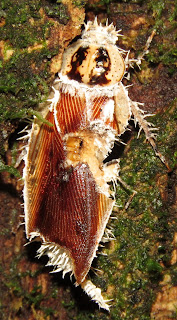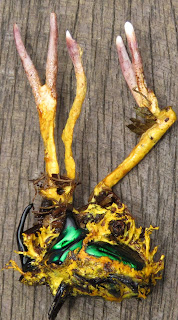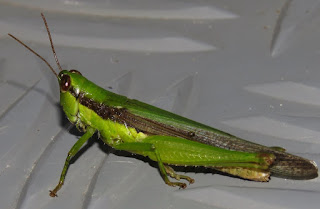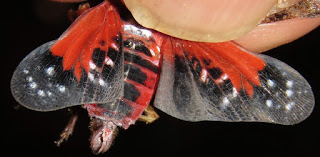January 10, 2020
This morning I wanted to sleep in a bit after the big party last night, so I chose to join the late-departing non-birding group on their trail walk on the system that begins behind the lodge.
I hung back much of the time, though I didn’t want to miss what their guide Jessica was showing the group. She talks about a lot of other aspects of natural history, uses of plants, and even folklore, most of which I don’t know. I’m sure I missed out while getting photos and a sound recording of this little frog, an Allobates sp. that was not like the one I’ve heard and photographed on the other side of the Cristalino River. No one seems to know what it is, and new species are being described in this long-neglected genus all the time. The Cristalino reserve is ripe for a new herpetological survey by someone who knows what they’re doing.
These pleasing fungus beetle larvae were devouring this fungus. There are probably dozens of Erotylids here and thousands of fungi, but this particular species of beetle seems to be the only one that feeds in groups like this on just this one fungus, as there are photos much like this one from all throughout the Amazon.
I found two Cordycipitaceous fungi. This was the first I had found on a cockroach, a first for me.
Even more exciting was finding this dead Oxysternon conspicillatum dung beetle with what appears to be the same fungus that I found a week earlier, Nigelia martiales, this one with much more developed fruiting bodies. It’s interesting that these dung beetles are closely related, the only ones I’ve ever found killed by a fungus, and it appears to be the same species of fungus.
We all walked right under this Reidy’s Wandering Spider, Phoneutria reidyi, guarding her egg sac on a tree trunk. She’s not really that close – I really zoomed in on this. I think a spider this venomous might be quite willing to bite if you got too close to her treasure.
While we were maneuvering around each other to get better looks at the spider, Corey looked up into the canopy beyond it and said, “What the f**k is that.” She took a couple steps toward what she was looking at and announced that she had found a sloth! My second ever Linnaeus’s Two-toed Sloth, Choloepus didactylus, was right over the trail.
We were just 10 minutes from the lodge, on our way to lunch, so I was able to round up everyone else and all got to see this amazing find. The next day it was gone.
At the lodge during the after-lunch break, some cool things were found. This shield mantis, Choeradodis rhomboidea, was one of them.
I had thought this silver-backed spider was a jumping spider from the general shape, but the eye arrangement is all wrong. It turns out to be in Oxyopidae, the lynx spiders, all members of which I had seen before are the distinctive, green members of the genus Peucetia. Like them, this one does have the very spiny legs.
Another group had found a roosting Short-tailed Nighthawk high in a tree on the Caja trail during their morning birding, so I went down the trail with them to look for it. Two different times we were unable to relocate the same tree, so I never saw it (I saw one roosting once in Costa Rica), but as a consolation I heard then whistled in this Purple-throated Fruitcrow, a very rare bird at Cristalino. There are three or four previous records, but I think this is the first photo documentation.
For the afternoon outing I stuck with Jessica’s non-birding group for a boat ride up to the Hoatzin Lagoons for the second day in a row. I rarely get up river that far, and I’d never done it in the afternoon. This time, we were treated to a noisy family of Giant Otters, Pteronura brasiliensis.
Also different from yesterday’s outing were the many Scaled Pigeons that we saw; none had been around yesterday morning.
As we boated through the water-hyacinths in the oxbows, numbers of these Cornops frenatum grasshoppers leapt into the boat.
I led a second night walk this evening, which led to no snakes and had to be aborted when it began to rain, but not before we heard a Long-tailed Potoo and even got a view of it flying over high. Someone spotted this fulgorid on a tree trunk. UPDATE (2 July 2020): This has been identified by Chris Mallory on iNaturalist as Artacie haemoptera – the first submission to iNaturalist!
And as I mentioned in a previous blog, most fulgorids have some nice surprise in the hind wing if you open them up.
This spiny katydid is advertising that you shouldn’t pick it up.
This erebid moths is Latebraria albosigma, one I usually see perched on vegetation at night and rarely at lights.
A second Reidy’s Wandering Spider for the day had been lucky with this huge katydid, though it seems to have been unlucky to have lost a leg in a previous encounter.























No comments:
Post a Comment